
The history of Moravia , one of the Czech lands, is diverse and characterized by many periods of foreign governance.

The history of Moravia , one of the Czech lands, is diverse and characterized by many periods of foreign governance.
Early modern humans had settled in the region by the Paleolithic. The Předmostí archaeological site in Moravia is dated to between 24,000 and 27,000 years old. [1] [2]

Around 60 BC the Celtic Volcae people withdrew from the region and were succeeded in turn by the Germanic Quadi. Several hundred years later, in the 6th century AD the Slavic tribes arrived in this territory often crossed during the Migration Period by successive Germanic and major Slavic tribes. At the end of the 8th century the Moravian Principality came into being in present-day south-eastern Moravia, Záhorie in south-western Slovakia and parts of Lower Austria. In 833 AD, this became the state of Great Moravia with the conquest of the Principality of Nitra (present-day Slovakia). Their first king was Mojmír I (ruled 830–846). Louis the German invaded Moravia and replaced Mojmír I with his nephew Rastiz who became St. Rastislav. [3] St. Rastislav (846–870) tried to emancipate his land from the Carolingian influence, so he sent envoys to Rome to get missionaries to come. When Rome refused he turned to Constantinople to the Byzantine emperor Michael. The result was the mission of Saints Cyril and Methodius who translated liturgical books into Slavonic, which had lately been elevated by the Pope to the same level as Latin and Greek. Methodius became the first Moravian archbishop, but after his death the German influence again prevailed and the disciples of Methodius were forced to flee. So the unique situation which anticipated the II Vatican Council by several centuries was destroyed. Great Moravia reached its greatest territorial extent in the 890s under Svatopluk I. At this time, the empire encompassed the territory of the present-day Czech Republic and Slovakia, the western part of present Hungary (Pannonia), as well as Lusatia in present-day Germany and Silesia and the upper Vistula basin in southern Poland. After Svatopluk's death in 895, the Bohemian princes defected to become vassals of the East Frankish ruler Arnulf of Carinthia, and the Moravian state ceased to exist after being overrun by invading Magyars in 906/7.


Following the defeat of the Magyars by Emperor Otto I at the Battle of Lechfeld in 955, Otto's ally Boleslaus I, the Přemyslid ruler of Bohemia, received Moravia. Bolesław I Chrobry of Poland annexed Moravia in 999, and ruled it until 1019, [4] when the Přemyslid prince Bretislaus recaptured it. Since then, Moravia has shared its history with Bohemia. Upon his father's death in 1034, Bretislaus also became the ruler of Bohemia. In 1055, Bretislaus decreed that the Bohemia and Moravia would be inherited together by primogeniture, although he also provided that his younger sons should govern parts (quarters) of Moravia as vassals to his oldest son. [5]
Throughout the Přemyslid era, junior princes often ruled all or part of Moravia from Olomouc, Brno or Znojmo, with varying degrees of autonomy from the ruler of Bohemia. (Mainly Dukes of Olomouc usually used to act as "right hand" of Prague dukes and kings. Dukes of Brno and especially those of Znojmo were much more insubordinate.) Moravia reached its height of autonomy in 1182, when Emperor Frederick I elevated Conrad II Otto of Znojmo to the status of a margrave, [6] immediately subject to the emperor, independent of Bohemia. This status was short-lived: in 1186, Conrad Otto was forced to obey the supreme rule of Bohemian duke Frederick. Three years later, Conrad Otto succeed to Frederick as Duke of Bohemia and subsequently canceled his margrave title. Nevertheless, the margrave title was restored in 1197 when Vladislaus III, Duke of Bohemia resolved the succession dispute between him and his brother Ottokar by abdicating from the Bohemian throne and accepting Moravia as a vassal land of Bohemian (i.e., Prague) rulers. Vladislaus gradually established this land as Margraviate, slightly administratively different from Bohemia.

The main line of the Přemyslid dynasty became extinct in 1306, and in 1310 John of Luxembourg became Margrave of Moravia and King of Bohemia. In 1333, he made his son Charles the next Margrave of Moravia (later in 1346, Charles become also the King of Bohemia). In 1349, Charles gave Moravia to his younger brother John Henry who ruled in the margraviate until his death in 1375, after him Moravia was ruled by his oldest son Jobst of Moravia who was in 1410 elected the Holy Roman King but died in 1411 (at present day, he is buried with his father in the Church of St. Thomas in Brno – the Moravian capital which they both ruled from). Moravia and Bohemia remained within the Luxembourg dynasty of Holy Roman kings and emperors (except during the Hussite Wars), until inherited by Albert II of Habsburg in 1437. [5]
After his death followed the interregnum until 1453; land (as the rest of lands of the Bohemian Crown) was administered by the landfriedens (landfrýdy). The rule of young Ladislaus the Posthumous subsisted only less than five years and subsequently (1458) the Hussite George of Poděbrady was elected as the king. He again reunited all Czech lands (then Bohemia, Moravia, Silesia, Upper & Lower Lusatia) into one-man ruled state. In 1466, Pope Paul II excommunicated George and forbade all Catholics (i.e. c. 15% of population) from continuing to serve him. The Hungarian crusade followed and in 1469 Matthias Corvinus conquered Moravia and proclaimed himself (with assistance of rebelling Bohemian nobility) as the king of Bohemia.
The subsequent 21-year period of a divided kingdom was decisive for the rising awareness of a specific Moravian identity, distinct from that of Bohemia. Although Moravia was reunited with Bohemia in 1490 when Vladislaus Jagiellon, king of Bohemia, also became king of Hungary, some attachment to Moravian "freedoms" and resistance to government by Prague continued until the end of independence in 1620. In 1526, Vladislaus' son Louis died in battle and the Habsburg Ferdinand I was elected as his successor.

The epoch 1526–1620 was marked by increasing animosity between Catholic Habsburg kings (emperors) and the Protestant Moravian nobility (and other Crowns') estates. Moravia, like Bohemia, was a Habsburg possession until the end of World War I. In 1573 the Jesuit University of Olomouc was established; this was first university in Moravia. The establishment of a special papal seminary, Collegium Nordicum, made the university a centre of the Catholic Reformation and effort to revive Catholicism in Central and Northern Europe. The second largest group of students were from Scandinavia.
From 1599 to 1711, Moravia was frequently subjected to raids by the Ottoman Empire and its vassals (especially the Tatars and Transylvania). Overall, hundreds of thousands were enslaved whilst tens of thousands were killed. [7]
Until 1641 Moravia's capitals were Brno and Olomouc, but after the capture of Olomouc by the Swedes, the city of Brno become the sole capital (Brno was the only city in Moravia which successfully resisted the invaders). The Margraviate of Moravia had (from 1348 in Olomouc and Brno) its own Diet (parliament) – zemský sněm (Landtag in German), whose deputies from 1905 onward were elected separately from the ethnically separate German and Czech constituencies. [5]
In 17th century Moravia, today's oldest theatre building in Central Europe was founded – Reduta Theatre. In 1740, Moravia was invaded by Prussian forces under Frederick the Great, and Olomouc was forced to surrender on 27 December 1741. A few months later the Prussians were repelled, mainly because of their unsuccessful siege of Brno in 1742. In 1758, Olomouc was besieged by Prussians again but this time, defenders of Olomouc forced the Prussians to withdraw following the Battle of Domstadtl. In 1777, a new Moravian bishopric was established in Brno, and the Olomouc bishopric was raised to archbishopric. In 1782, the Margaviate of Moravia was merged with the Austrian Silesia into the Moravia-Silesia, with Brno as its capital city. This lasted until 1850. [5]
Following the break-up of the Austro-Hungarian Empire in 1918, Moravia became part of Czechoslovakia. As one of the five lands of Czechoslovakia, it had restricted autonomy. In 1928 Moravia ceased to exist as a territorial unity and was merged with Czech Silesia into the Moravian–Silesian Land. After the German occupation of Czechoslovakia in World War II, Moravia was divided – part was made an administrative unit within the Protectorate of Bohemia and Moravia and the area with more ethnic Germans was absorbed by the German Third Reich.
In 1945 after the end of World War II and Allied defeat of Germany, Czechoslovakia, expelled the ethnic German minority of Moravia to Germany and Austria. The Moravian–Silesian Land was restored with Moravia as part of it. In 1949 the territorial division of Czechoslovakia was radically changed, as the Moravian-Silesian Land was abolished and Lands were replaced by kraje (regions), whose borders substantially differ from the historical Bohemian-Moravian border, so Moravia politically ceased to exist after approx. 1116 years (833–1949) of its history.
After the fall of the Soviet Union, the Czechoslovak Federal Assembly condemned the cancellation of Moravian–Silesian land and expressed "firm conviction that this injustice will be corrected" in 1990, however after the breakup of Czechoslovakia into Czech Republic and Slovakia in 1993, Moravian land remained in the Czech territory, and the latest administrative division of Czech Republic (which was introduced in 2000) is nearly identical with the administrative division of 1949. [5]

Moravia is a historical region in the east of the Czech Republic and one of three historical Czech lands, with Bohemia and Czech Silesia.
The history of the Czech lands – an area roughly corresponding to the present-day Czech Republic – starts approximately 800 years BCE. A simple chopper from that age was discovered at the Red Hill archeological site in Brno. Many different primitive cultures left their traces throughout the Stone Age, which lasted approximately until 2000 BCE. The most widely known culture present in the Czech lands during the pre-historical era is the Únětice Culture, leaving traces for about five centuries from the end of the Stone Age to the start of the Bronze Age. Celts – who came during the 5th century BCE – are the first people known by name. One of the Celtic tribes were the Boii (plural), who gave the Czech lands their first name Boiohaemum – Latin for the Land of Boii. Before the beginning of the Common Era the Celts were mostly pushed out by Germanic tribes. The most notable of those tribes were the Marcomanni and traces of their wars with the Roman Empire were left in south Moravia.
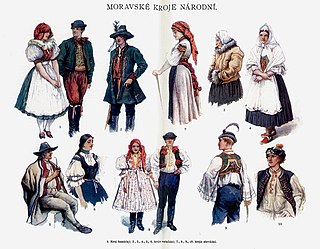
Moravians are a West Slavic ethnic group from the Moravia region of the Czech Republic, who speak the Moravian dialects of Czech or Common Czech or a mixed form of both. Along with the Silesians of the Czech Republic, a part of the population to identify ethnically as Moravian has registered in Czech censuses since 1991. The figure has fluctuated and in the 2011 census, 6.01% of the Czech population declared Moravian as their ethnicity. Smaller pockets of people declaring Moravian ethnicity are also native to neighboring Slovakia.

The Czech lands or the Bohemian lands is a historical-geographical term which, in a historical and cultural context, denotes the three historical regions of Bohemia, Moravia, and Czech Silesia out of which Czechoslovakia, and later the Czech Republic, were formed. Together the three have formed the Czech part of Czechoslovakia since 1918, and the Czech Republic since 1 January 1993.

The Duchy of Bohemia, also later referred to in English as the Czech Duchy, was a monarchy and a principality of the Holy Roman Empire in Central Europe during the Early and High Middle Ages. It was formed around 870 by Czechs as part of the Great Moravian realm. Bohemia separated from disintegrating Great Moravia after Duke Spytihněv swore fealty to the East Frankish king Arnulf in 895.

Vladislaus Henry, a member of the Přemyslid dynasty, was elected Duke of Bohemia in 1197 and Margrave of Moravia from 1197 until his death. He only served as duke during the year 1197 and was indeed the last ruler of Bohemia to hold that title. It was his brother Ottokar I, whose forces overthrew him, who finally achieved the elevation of the Duchy of Bohemia to the status of a kingdom starting in 1198.

Henry Bretislav, a member of the Přemyslid dynasty, was Bishop of Prague from 1182, then Duke of Bohemia as "Bretislav III" from 1193 to his death.

Bretislav I, known as the "Bohemian Achilles", of the Přemyslid dynasty, was Duke of Bohemia from 1034 until his death in 1055.
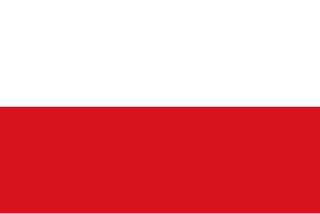
The Lands of the Bohemian Crown were the states in Central Europe during the medieval and early modern periods with feudal obligations to the Bohemian kings. The crown lands primarily consisted of the Kingdom of Bohemia, an electorate of the Holy Roman Empire according to the Golden Bull of 1356, the Margraviate of Moravia, the Duchies of Silesia, and the two Lusatias, known as the Margraviate of Upper Lusatia and the Margraviate of Lower Lusatia, as well as other territories throughout its history. This agglomeration of states nominally under the rule of the Bohemian kings was referred to simply as Bohemia. They are now sometimes referred to in scholarship as the Czech lands, a direct translation of the Czech abbreviated name.
This article deals with historic administrative divisions of Czechoslovakia up to 1992, when the country was split into the Czech Republic and Slovakia.
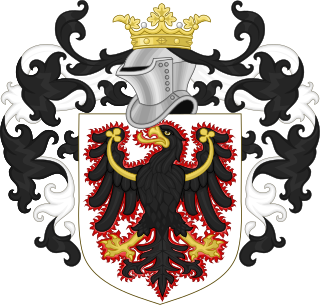
The Přemyslid dynasty or House of Přemysl was a Bohemian royal dynasty that reigned in the Duchy of Bohemia and later Kingdom of Bohemia and Margraviate of Moravia, as well as in parts of Poland, Hungary and Austria.
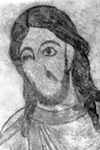
Svatopluk the Lion was Duke of Bohemia from 1107 until his assassination in 1109. His rule was overshadowed by the fierce conflict around the Bohemian throne in the 12th century.
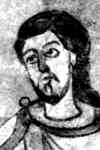
Soběslav I was Duke of Bohemia from 1125 until his death in 1140. He was a member of the Přemyslid dynasty, the youngest son of Vratislaus II, by his third wife Świętosława of Poland.

Frederick, a member of the Přemyslid dynasty, was Duke of Bohemia from 1172 to 1173 and again from 1178 to his death.
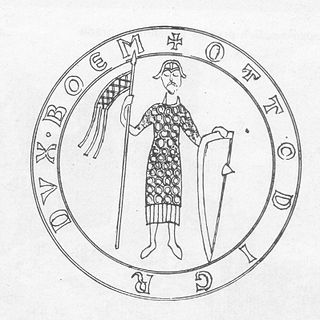
Conrad II Otto, a member of Přemyslid dynasty, was the first margrave of Moravia from 1182 to 1189 and duke of Bohemia from 1189 until his death.

The Duchy of Krnov or Duchy of Jägerndorf was one of the Duchies of Silesia, which in 1377 emerged from the Duchy of Troppau (Opava), itself a fief of the Bohemian Crown. Its capital was at Krnov in the present-day Czech Republic.

The Margraviate of Moravia was one of the Lands of the Bohemian Crown within the Holy Roman Empire and then Austria-Hungary, existing from 1182 to 1918. It was officially administered by a margrave in cooperation with a provincial diet. It was variously a de facto independent state, and also subject to the Duchy, later the Kingdom of Bohemia. It comprised the historical region called Moravia, which lies within the present-day Czech Republic.

Ulrich I, Duke of Brno was the Duke of Moravia for twenty one years - between 1092 and 1113. He was the first son and successor of Conrad I, Duke of Bohemia and Wirpirk of Tengling. He did not succeed as half ruler of Moravia (diarch), for all half of Moravia as his father Conrad I, but Brno was divided into two parts: Brno and Znojmo and Ulrich was co-ruler in this part with his brother Luitpold of Znojmo. Both brothers together established a benedictine cloister and its St. Procopius Basilica in Třebíč and prepared as mausoleum for Brno-Znojmo branch House of Přemyslid.

The coat of arms of Moravia has been used for centuries to represent Moravia, a traditional province in the present-day Czech Republic. The coat of arms is also present in a field of the coat of arms of the Czech Republic.

Conrad II of Znojmo, a member of the Přemyslid dynasty, was a Bohemian prince who ruled in the Moravian principality of Znojmo from 1123 to 1128 and again from 1134 until his death.
{{cite journal}}: CS1 maint: multiple names: authors list (link)